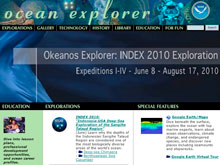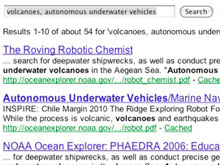Quicktime7 (H.264), 160x120, 1.2 Mb
Quicktime7 (H.264), 640x360, 19.4 Mb
Quicktime7 (H.264), 960x540, 32.7 Mb
Downloads:
Windows Media, 960x540, 15.7 Mb
MP3 (Audio), 7.3 Mb
Powerpoint Presentation, 75.3 Mb
You may need to download: Quicktime ![]() | Windows Media
| Windows Media ![]()
Part One - Site Overview

Slide 1:
NOAA’s Office of Ocean Exploration and Research envisions "A society in which citizens understand the importance of the ocean to all life on Earth and are informed and inspired by discoveries that reveal the wonder and mysteries of the ocean." Our mission is "To support NOAA and National objectives by exploring the Earth's largely unknown oceans in all their dimensions for the purpose of discovery and the advancement of knowledge, using state-of-the-art technologies in evolutionary and revolutionary ways."
Our efforts are supported by a dynamic, award-winning Web site, oceanexplorer.noaa.gov, designed to engage visitors in the excitement of deep open ocean exploration and discovery. Ocean explorations to little known and unknown regions of the world take place throughout the year and are highlighted on the Ocean Explorer Web site. Educators can use the information provided by the scientists and educators participating in the expeditions and the lesson plans tied specifically to the expeditions to bring ocean science exploration directly into their classrooms.
This short slide presentation will take you through the key elements of the Web site and emphasize those pieces particularly suitable for classroom use. You can then use the associated self-guided Web exploration to delve deeper into all that is available on this site.
Slide 2:
As you can see across the top of the Ocean Explorer Home Page, we provide links directly to:
- our Explorations to little known or unknown regions of the world ocean
- a Gallery section filled with images and videos from our expeditions
- a Technology Section that focuses on underwater submersibles used in ocean exploration
- a History Section that highlights the history of ocean exploration
- a Library filled with additional resources
- an Education Section that houses a wealth of resources
- a For Fun Section
- and a Search feature.
We’ll be visiting each of these sections during this tutorial in a few minutes, but first notice the bar of links in the center of the home page with sections entitled:
- Education
- Explorations
- and Special Features.
It’s important to note that there are several ways to navigate this site, as we wanted to highlight some of the most popularly visited areas of the site for the general public as well. We will first navigate through the top navigation bar to give you an overall feel for the site. Then we’ll come back to the homepage and briefly navigate through the Education, Explorations and Special Features bar in the center of the homepage.
Slide 3:
Let’s begin with clicking on Explorations (also referred to as Expeditions). These are missions that are archived back to 2001 when the program was first established. As you visit the Web site, you can search explorations by year by clicking on the green boxes in the center of the main exploration page or by typing a topic of interest into the Search box in the top right corner. Let’s use the search engine and search for volcanoes and an autonomous underwater vehicle or AUV.

Slide 4:
Use of the search engine will bring up a list of items from the Ocean Exploration Web site. This may include background information on the topic, lesson plans, trip logs, videos and specific expeditions.
If you were to search for “volcano lesson plans” the search engine would provide you with all lessons on underwater volcanoes on the ocean exploration Web site.
Slide 5:
Once you select and click on an expedition, the main page of that expedition appears. The example here is the 2007 Submarine Ring of Fire Expedition. Here you will find the name of the expedition, the expedition dates, and an introduction to its purpose.
On the left side of the page you will find a Mission Plan, which goes into more detail about the expedition, and includes images to support the content.
An Education Section contains all of the education resources that have been developed to support the expedition, from lesson plans in early years of the program to Expedition Education Modules (EEMs) developed to support current expeditions. The lessons and resources contained within the EEMs will be discussed when we get to the Education Section of the Web site.
Topical background science essays directly related to the exploration activities are also developed for each mission and are represented in this particular mission under the titles Kermadec Arc, Volcanic CO2, and AUV mapping. Notice these in the left hand column.
An Explorers section includes short biographies and, sometimes, links to homepages from scientists, graduate students and others participating in the mission. This is a terrific career component for students interested in learning more about the people behind the mission itself.
Notice the daily logs on the right side of the page. These are produced daily by scientists and others on board the ship and always contain compelling images and video. It’s a great way to join the expedition online and keep up with day-to-day happenings of life at sea and the discoveries made on a deep-sea expedition.
When an expedition is live, there’s an “Ask-an-Explorer” feature on the right hand side of the page. Here, anyone can send a question to the scientists on board the ship and receive an answer online.
When the exploration is completed, a mission summary is posted in the top right hand corner, along with a photo and video log of the mission which contains all of the images and video collected during the mission. All of this information is then archived on our Web site for easy access.
Slide 6:
Looking for great pictures of multibeam sonar maps, underwater volcanoes or deep sea jellyfish? Click on the Gallery link at the top of the Ocean Exploration Home page. Here you will find images and video from all Ocean Exploration Expeditions organized by topic area, such as Maps, Living Ocean, Sound in the Sea, Cultural Heritage, and more. All this can be downloaded to your computer at no charge.
Slide 7:
Moving on to the Technology link, here you can find background information and images of many of the latest vessels, submersibles, Remotely Operated Vehicles, or ROVs, and Autonomous Underwater Vehicles, or AUVs.
Slide 8:
In the History section you can search information on ocean exploration back to the early 1800s.
Slide 9:
Clicking on the Ocean Explorer Library will take you to a selection of resources significant to NOAA's historical and current ocean exploration activities. Resources here include publications, historical documents, background on the National Oceanic and Atmospheric Administration, and a digital library of readings about ocean explorers.
Related Links
Ocean Explorer Website Tutorial: Part Two - Education
Ocean Explorer Website Tutorial: Part Three - Okeanos Explorer
Ocean Explorer Website Tutorial: Part Four - Special Features
Ocean Explorer Website Tutorial: Full Video
NOAA Ocean Explorer: Education
NOAA Ocean Explorer: Explorations

